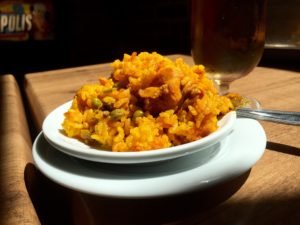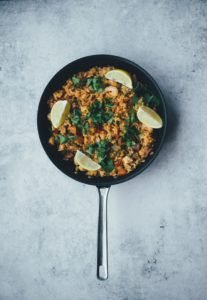
Paella is perhaps the most definitive Spanish meal. Famously developed in Valencia, Paella can now be found in restaurants and households all over Spain. Here is a quick guide to the different Paellas you can find in Spain, as well as a traditional Valencian Paella recipe!
Five Amazing Paella variations
While a Valencian would consider that the only genuine Paellas are Valencian (with rabbit) and Marinera (with seafood), there are in fact, many, many variations. Here are five of the most popular Paella recipes.
1. The original traditional Valencian Paella
A good Valencian Paella is mouthwatering! Combining tomato, garlic, pepper and onion with perfectly cooked rice, the result is to-die-for. Not to mention the colors! Sometimes called by visitors, "Spanish yellow rice recipe!". The Paella ingredients make this dish more than just yellow! The kaleidoscope of colors comes from the red tomatoes, green peppers, white rice, and yellow from saffron.

You'll find the recipe for this classic Valencian Paella below!
2. Paella Marinera (Seafood)

Paella Marinera simmering over hot coals
Second only to Valencian Paella, the Paella Marinera is particularly popular in Catalonia.
The fresh seafood ingredients make this lighter than the Valencian version- and a more Summery meal.
The word Paella

The other meaning of Paella
As with all Paellas, the traditional way of cooking involved placing the Paella over hot coals to cook outside, while enjoying a glass of wine or sangría.
(The word Paella means both the meal and the pan that it's cooked in.)
3. Black Paella

A freshly prepared Black Paella
Yes, that is squid ink! And it's delicious! It's salty though, so make sure you have plenty to drink!
Okay, so personally- this is my favorite Paella recipe. It has the saltiness of seafood and this rich squid ink flavour, and you can cut through all of this with the freshness of plenty of lemon juice squeezed all over. Mmmmm yum! With Corona beer from Mexico and I'm in heaven!
4. Mixed Paella

Mmmmmm...
If you just can't decide, or you want it all, the Mixed Paella (Paella Mixto) is for you!
This combines the best of both worlds- the hearty meat of the Valencian Paella, with the fresh saltiness of the Paella Marinera. The key is to first cook the meat (usually rabbit) sofrito (in a blend of oil, garlic, onion and tomato), and then add in the seafood (typically squid and prawns).
5. Vegetarian Paella

Steaming Vegetarian Paella
Honestly, Spain is not renowned for its vegetarian cuisine. (A tuna sandwich is considered vegetarian here!) Paella is no exception to this. However, with a changing culture, restaurants have begun to adapt and cater to vegetarian tastes, and Vegetarian Paella has emerged. This is essentially the classic Valencian Paella without meat. A good Vegetarian Paella will have some extra vegetables, such as mushrooms, artichokes and olives though.
While we usually call this "vegetaria paella", it is in fact vegan, so we could easily call it "Vegan Spanish rice"
To make this, simply follow the recipe below, leaving out the meat, and add a few extra Mediterranean vegetables according to your taste.

The secrets

- Use fresh spices
- Use short-grain rice
Ingredients
- 2 cups olive oil
- 1 red bell pepper, cut in strips
- 3/4 chicken, cut into pieces
- 1/2 rabbit, cut into pieces
- 1/2 teaspoon sweet paprika
- 1 1/2 pounds green beans, cut into 1-inch pieces
- 1 1/2 pounds broad beans, shelled
- 1/2 tomato, chopped
- 4 1/2 cups water, or fill up the paella pan to the height of the handles 2 times
- 2 cups snails, cleaned, fresh or frozen
- 1 1/4 pounds plus 1-ounce short grain rice (3.5 ounces per person)
- Salt and freshly ground pepper
- 1 pinch saffron, for coloring
- Sprigs rosemary, as garnish
Steps
All cooked in the Paella dish or a large shallow pan.
Heat 1/4 to 1/2 cup of the oil in the Paella. Add the pepper (cut into strips) and fry until begins to soften. Remove and reserve for garnish. Fry the chicken and rabbit at medium heat until golden brown, adding more oil, as needed. Add the paprika half way through to add color to meat- this is when it starts to look amazing. Push the meat out to the edges of the pan and add the beans and tomatoes in the center, making sure to mix them in well. Then add 1/2 of the water,and be sure to cover the pan until it is 1/2 full. This needs to simmer for approximately half and hour until most of the water has evaporated. You can then add the snails and cook for 5 or 10 minutes further.
For the last 1 to 2 minutes increase the heat to medium-high, until the bottom layer of rice starts to caramelize, creating what Valencians call the "socarrat". If the rice starts to burn remove the pan from the heat immediately.
Garnish with strips of red pepper, and sprigs of rosemary. Cover the pan and let the Paella rest for 5 minutes before serving. Prepare some sangría or open a bottle of wine and enjoy!
Posted from my blog with SteemPress : https://spainsecrets.com/spanish-paella/
Hi! I am a robot. I just upvoted you! I found similar content that readers might be interested in:
https://spainsecrets.com/spanish-paella/
Downvoting a post can decrease pending rewards and make it less visible. Common reasons:
Submit